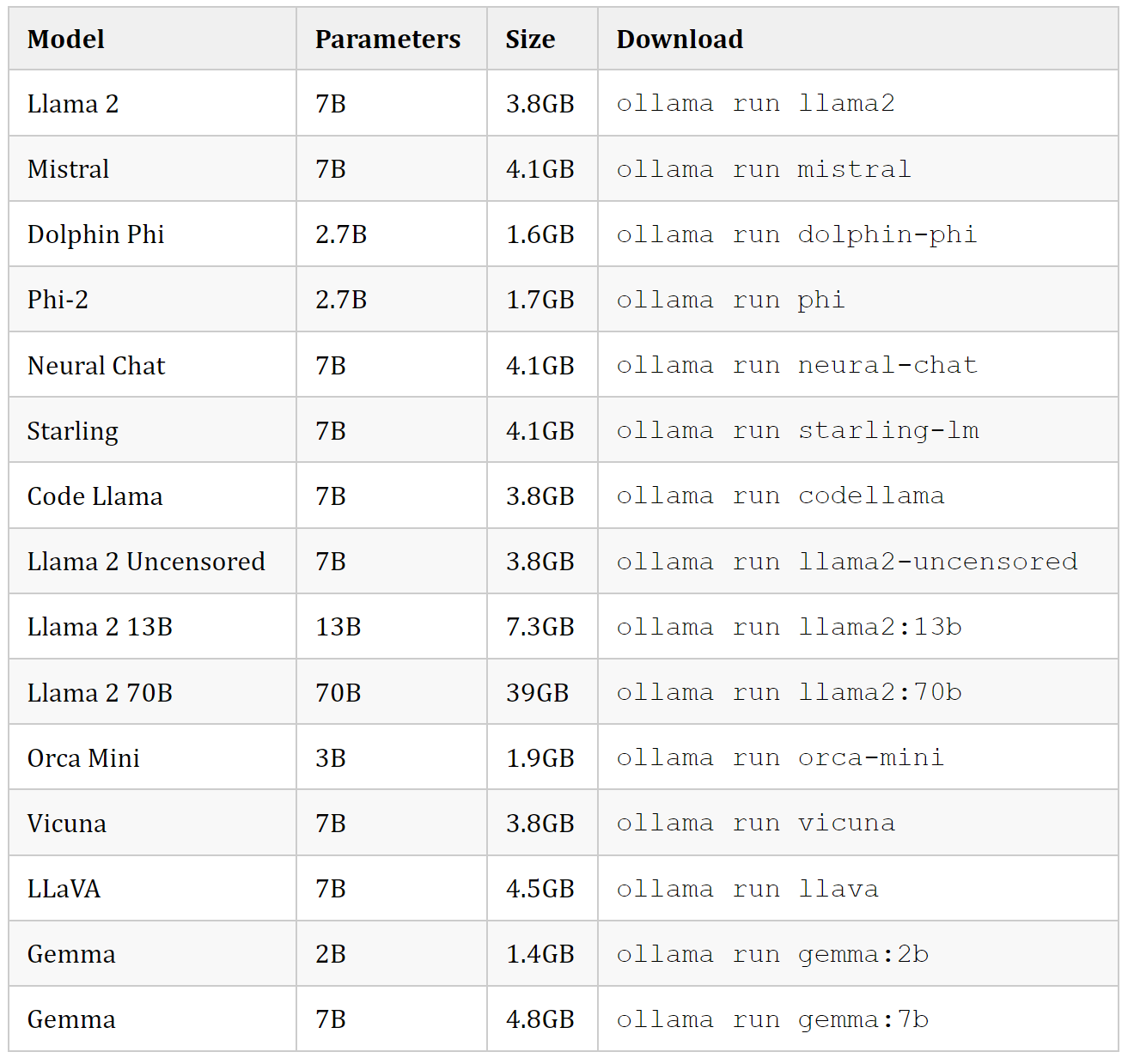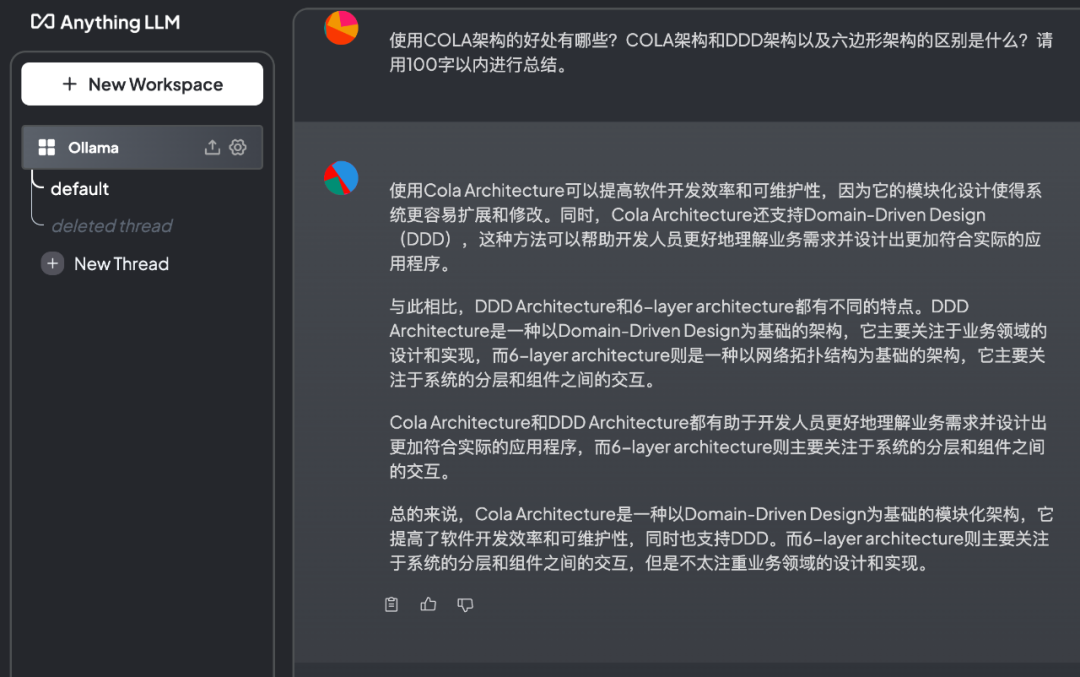Ollama VS Hugging Face
在本地快速运行大模型,可以使用 Ollama 和 Hugging Face。
如果想通过 Hugging Face 本地快速访问大模型一般有两种方式:
Inference API (Serverless)
import requests
API_URL = "https://api-inference.huggingface.co/models/meta-llama/Llama-2-7b-hf"
headers = {"Authorization": "Bearer xxxxxxxxxxxxxxxxxxxxxxxxxxxxxxxxxxxxx"}
def query(payload):
response = requests.post(API_URL, headers=headers, json=payload)
return response.json()
output = query({
"inputs": "Can you please let us know more details about your ",
})
本地执行
# Use a pipeline as a high-level helper
from transformers import pipeline
pipe = pipeline("text-generation", model="meta-llama/Llama-2-7b-hf")
所以通过Hugging Face 对于不懂编程的人来说是比较困难的,一是需要申请API Key,二是需要本地有Python或者其他编程语言的环境。使用Ollama来运行本地大模型就非常的简单。
Ollama
Ollama的下载地址:https://ollama.com/download, 安装后直接在终端中执行如下命令:
ollama run llama2:7b一般来说,7b的模型至少需要8G RAM,13b需要16G,70b需要64G。
在没有进行任何LLM训练,也没有通过检索增强生成(RAG)的情况下,你可以看到如下的回
function quicksort(arr) {
if (arr.length <= 1) {
return arr;
}
let pivot = arr[0];
let left = [];
let right = [];
for (let i = 1; i < arr.length; i++) {
if (arr[i] < pivot) {
left.push(arr[i]);
} else {
right.push(arr[i]);
}
}
return quicksort(left).concat([pivot], quicksort(right));
}image-20240324151821599
以下是一些可以下载的示例模型,也可到官方网站查看可支持的model列表:https://ollama.com/library:
Model Parameters Size Download
Llama 2 7B 3.8GB ollama run llama2
Mistral 7B 4.1GB ollama run mistral
Dolphin Phi 2.7B 1.6GB ollama run dolphin-phi
Phi-2 2.7B 1.7GB ollama run phi
Neural Chat 7B 4.1GB ollama run neural-chat
Starling 7B 4.1GB ollama run starling-lm
Code Llama 7B 3.8GB ollama run codellama
Llama 2 Uncensored 7B 3.8GB ollama run llama2-uncensored
Llama 2 13B 13B 7.3GB ollama run llama2:13b
Llama 2 70B 70B 39GB ollama run llama2:70b
Orca Mini 3B 1.9GB ollama run orca-mini
Vicuna 7B 3.8GB ollama run vicuna
LLaVA 7B 4.5GB ollama run llava
Gemma 2B 1.4GB ollama run gemma:2b
Gemma 7B 4.8GB ollama run gemma:7b

AnythingLLM
可以通过AnythingLLM等现代化界面进行交互,而不是终端的方式。
Ollama其实有两种模式:
聊天模式
服务器模式
这里使用服务器模式,Ollama在后端运行大模型,开发ip和端口给外部软件使用。
ollama serve
通过终端或者命令行,访问http://localhost:11434 进行验证:
curl http://localhost:11434
Ollama is running
搭建一个本地知识库,会涉及到三个关键:
LLM Model,大语言模型。它负责处理和理解自然语言。
Embedding Model,嵌入模型。它负责把高维度的数据转化为低维度的嵌入空间。这个数据处理过程在RAG中非常重要。
Vector Store,向量数据库,专门用来高效处理大规模向量数据。
本地容器化安装AnyThingLLM
参考文档:https://github.com/Mintplex-Labs/anything-llm/blob/master/docker/HOW_TO_USE_DOCKER.md
Linux或MacOS执行如下命令:
export STORAGE_LOCATION=$HOME/anythingllm && \
mkdir -p $STORAGE_LOCATION && \
touch "$STORAGE_LOCATION/.env" && \
docker run -d -p 3001:3001 \
--cap-add SYS_ADMIN \
-v ${STORAGE_LOCATION}:/app/server/storage \
-v ${STORAGE_LOCATION}/.env:/app/server/.env \
-e STORAGE_DIR="/app/server/storage" \
mintplexlabs/anythingllm
使用 http://localhost:3001 访问。
官方有一段这样的描述:
If you are in docker and cannot connect to a service running on your host machine running on a local interface or loopback:
localhost
127.0.0.1
0.0.0.0
On linux http://host.docker.internal:xxxx does not work. Use http://172.17.0.1:xxxx instead to emulate this functionality.
Then in docker you need to replace that localhost part with host.docker.internal. For example, if running Ollama on the host machine, bound to http://127.0.0.1:11434 you should put http://host.docker.internal:11434 into the connection URL in AnythingLLM.
本地大模型选择
图片
image-20240324154453634
embedding配置
可以选择:https://ollama.com/library/nomic-embed-text 或者AnythingLLM自带。
图片
image-20240324154828615
向量数据库配置
可以参看我之间的公众号文章:AI Agent 实战,或者 博文:https://flyeric.top/archives/setup-langchain-ai-agent-practice ,构建本地的Vector Database。也可注册Pinecone免费试用。
图片
